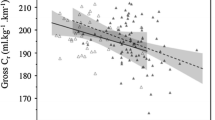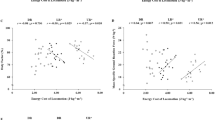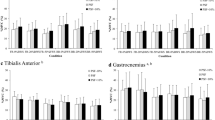Abstract
Metabolic cost of submaximal running at constant speed is influenced by various factors including fatigue and kinematic characteristics. Metabolic costs typically drift upwards during extended running while stride characteristics often shift away from initial. When non-fatigued, experienced runners naturally optimize stride frequency in a manner that minimizes oxygen uptake. An initial objective was to determine whether runners demonstrate a similar self-optimizing capability when fatigued where stride characteristics have perhaps shifted away from the initial state. A secondary objective involved measurement of vertical and leg stiffness characteristics as a potential explanation for frequency changes with fatigue. We hypothesized that runners decrease stride frequency and stiffness with fatigue while optimizing these characteristics to minimize metabolic cost. Sixteen experienced runners completed a near maximal effort 1-h treadmill run at a constant speed. Preferred and optimal stride frequencies (PSF and OSF) were measured near the beginning and end of the hour run using frequencies ±4 and ±8% around PSF. From vertical force data recorded throughout the run, leg and vertical stiffness were determined. As expected, oxygen uptake significantly increased during the run from 45.9 to 47.4 ml kg−1 min−1 (P = 0.004). There was no difference between preferred and optimal stride frequencies at the beginning or the end of running (P = 0.978), however both PSF and OSF significantly decreased from 1.45 to 1.43 Hz (P = 0.026). All runners self-optimized stride frequency at the beginning and end of one-hour of running despite changes of optimal stride frequency. Stiffness and stride frequency changes were subject specific with some runners exhibiting little to no change. No clear relationship of frequency or stiffness changes to economy was found.



Similar content being viewed by others
References
Belli A, Lacour JR, Komi PV, Candau R, Denis C (1995) Mechanical step variability during treadmill running. Eur J Appl Physiol 70:510–517
Candau R, Belli A, Millet GY, Georges D, Barbier B, Rouillon JD (1998) Energy cost and running mechanics during a treadmill run to voluntary exhaustion in humans. Eur J Appl Physiol 77:479–485
Cavagna GA (1975) Force platforms as ergometers. J Appl Physiol 39:174–179
Cavagna GA, Mantovani M, Willems PA, Musch G (1997) The resonant step frequency in human running. Pflügers Arch Eur J Physiol 434:678–684
Cavanagh PR, Williams KR (1982) The effect of stride length variation on oxygen uptake during distance running. Med Sci Sports Exerc 14:30–35
Costill DL (1967) The relationship between selected physiological variables and distance running performance. J Sports Med Phys Fitness 7:61–66
Dalleau G, Belli A, Bourdin M, Lacour JR (1998) The spring–mass model and the energy cost of treadmill running. Eur J Appl Physiol 77: 257–263
Derrick TR, Dereu D, Mclean SP (2002) Impacts and kinematic adjustments during an exhaustive run. Med Sci Sports Exerc 34:998–1002
Dutto DJ, Smith GA (2002) Changes in spring–mass characteristics during treadmill running to exhaustion. Med Sci Sports Exerc 34:1324–1331
Farley CT, Gonzalez O (1996) Leg stiffness and stride frequency in human running. J Biomech 29:181–186
Fewster J (1996) The role of musculoskeletal forces in the human walk–run transition. Unpublished master’s thesis, Oregon State University, Corvallis, Oregon
Gardner JB, Purdy JG (1970) Computerized running training programs. Track & Field News, Los Altos
Heise GD, Martin PE (1998) “Leg spring” characteristics and the aerobic demand of running. Med Sci Sports Exerc 30: 750–754
Kaneko M, Matsumoto M, Ito A, Fuchimoto T (1987) Optimal step frequency in constant speed running. In: Jonsson B (ed) Biomechanics X–B. Human Kinetics, Champaign, pp 803–807
Krustrup P, Söderlund K, Mohr M, Bangsbo J (2004) The slow component of oxygen uptake during intense, sub-maximal exercise in man is associated with additional fibre recruitment. Pflugers Arch Eur J Physiol 447:855–866
Kubo K, Kanehisa H, Kawakami Y, Fukunaga T (2001) Effects of repeated muscle contractions on the tendon structures in humans. Eur J Appl Physiol 84:162–166
Kuitunen S, Avela J, Kyröläinen H, Nicol C, Komi PV (2002) Acute and prolonged reduction in joint stiffness in humans after exhausting stretch–shortening cycle exercise. Eur J Appl Physiol 88:107–116
Kyröläinen H, Pullinen T, Candau R, Avela J, Huttunen P, Komi PV (2000) Effects of marathon running on running economy and kinematics. Eur J Appl Physiol 82:297–304
Maclaren DPM, Gibson H, Parry-Billings M, Edwards RHT (1989) A review of metabolic and physiological factors in fatigue. In: Pandolf KB (ed) Exercise and sport sciences reviews. Williams & Wilkins, Baltimore, pp 29–66
McMahon TA, Cheng GC (1990) The mechanics of running: how does stiffness couple with speed? J Biomech 23:65–78
Millet G, Lepers R, Lattier G, Martin V, Babault N, Maffiuletti N (2000) Influence of ultra-long-term fatigue on the oxygen cost of two types of locomotion. Eur J Appl Physiol 83:376–380
Morin J-B, Dalleau G, Kyröläinen H, Jeannin T, Belli A (2005) A simple method for measuring stiffness during running. J Appl Biomech 21:167–180
Noakes TD (2000) Physiological models to understand exercise fatigue and the adaptations that predict or enhance athletic performance. Scand J Med Sci Sports 10:123–145
Place N, Lepers R, Deley G, Millet GY (2004) Time course of neuromuscular alterations during a prolonged running exercise. Med Sci Sports Exerc 36:1347–1356
Powers SK, Dodd S, Garner R (1984) Precision of ventilatory and gas exchange alterations as a predictor of the anaerobic threshold. Eur J Appl Physiol 52:173–177
Siler WL, Martin PE (1991) Changes in running pattern during a treadmill run to volitional exhaustion: fast versus slower runners. Int J Sport Biomech 7:12–28
Sproule J (1998) Running economy deteriorates following 60 min of exercise at 80% VO2max. Eur J Appl Physiol 77:366–371
Winter DA (1990) Biomechanics and motor control of human movement. Wiley, New York
Xu F, Montgomery DL (1995) Effect of prolonged exercise at 65 and 80% of VO2max on running economy. Int J Sports Med 16:309–315
Author information
Authors and Affiliations
Corresponding author
Rights and permissions
About this article
Cite this article
Hunter, I., Smith, G.A. Preferred and optimal stride frequency, stiffness and economy: changes with fatigue during a 1-h high-intensity run. Eur J Appl Physiol 100, 653–661 (2007). https://doi.org/10.1007/s00421-007-0456-1
Accepted:
Published:
Issue Date:
DOI: https://doi.org/10.1007/s00421-007-0456-1




